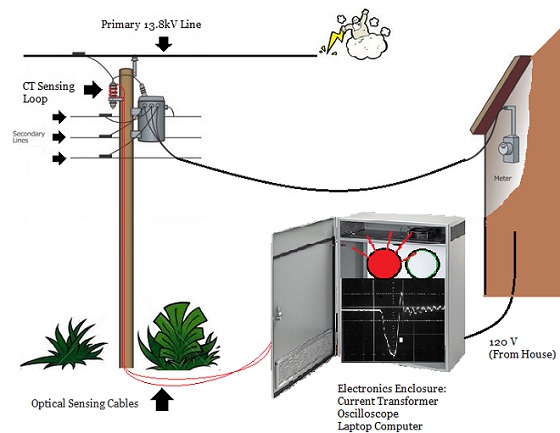A Portable Transient Detection System:Introduction:Our senior capstone project has two major components. The first is to produce a proposal to be submitted to APS for the elements of a portable transient detection system. The second is to do background research on transients and key elements of the portable system so that when the transient detection system is assembled, the users have a body of work to start with. Last semester, in EE 476 (Fall 2010), the project started in a different direction. The original goal was to find key elements of a transient detection system, purchase them, assemble, then test the system in a controlled environment. As the EE 476 semester progressed, we encountered quite a bit of trouble getting even a ballpark quote for the key element of out system, an optical current transformer. When we finally got a quote at the end of the semester, we found that the device was significantly over out budget of $5000. The optical current transformers are fairly expensive, at around $17,000 from most manufacturers. This set the cost of our proposed system to around $22,000. Due to a lack of funds, our project changed in nature. As outlined above, we will not be purchasing and putting together the entire system, but will instead write a complete proposal for the parts to be submitted to APS then do research related to how the system is intended to be used. The following problem statement and requirements will be for the portable detection system proposed. Problem Statement:Transient activity in the power systems of America account for around 80% of all electrically related downtime [1]. Currently power companies such as APS monitor transient activity via large current transformers located at strategic places on their higher voltage transmission lines and distribution hubs. Transient activity in lower voltage distribution lines is defined locally, and thus has not been studied in many areas. Our portable transient detection system would allow power companies to analyze the frequency and strengths of transients in local power lines. After analyzing a particular area, our system could be moved fairly easily and be redeployed in the next area of interest. The use of an optical current transformer in our system is justified by more than its portability. An optical current transformer does not work via induction like standard current transformers do, so there is no risk of damaging any attached hardware when the line has a particularly strong transient such as a lightning strike. Instead, optical current transformers work via the Faraday effect, which is the "bending" of polarity as light passes through a magnetic field [2],[3]. With the increasing use of solar panels tied to the grid in residential areas, there is growing potential for transient activity caused by sudden changes in light intensity in a neighborhood, such as when clouds pass rapidly overhead. Our portable transient detection system would be easily deployed in a neighborhood with many solar panels and could gather useful data for power companies on the effects of solar on local transient activity. A diagram of the proposed system is included below:
Requirements and Specifications:
** The strength of actual surges caused by lightning transients are relative to the location of the strike and may easily exceed 2X the continuous values if a strike is very near the optical transformer. This will register as a "data out of range" event by the current transformer. Equipment will not be damaged by very strong transients because the system does not work via induction. References[1]: Causes and Effects of Transient Voltages: http://www.tvss.net/trans/trans-x.htm (Accessed 11/10/2010) [2]: Faraday-Effect Optical Current Sensor with a Garnet Film/Ring Core in a Transverse Configuration, by Toshino Yoshino, Shin-ichi Torihata, Masayuki Yokota, and Noritake Taukada. Applied Optics, Vol. 42, No 10, 1 April 2003 [3]: E. Hecht: Optics, 2nd. Ed, 1987, Addison-Wesley. Pages 309-318 for application of Faraday Effect to sensing technologies |


A Portable Transient Detection System |
Funded by: sponsored by Dr. Allison Kipple
sponsored by Dr. Allison Kipple
|
